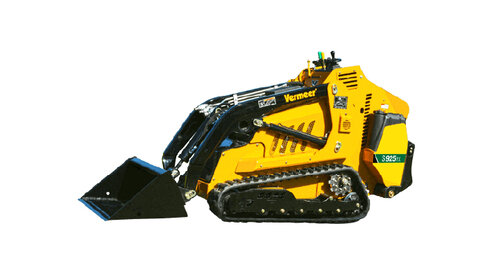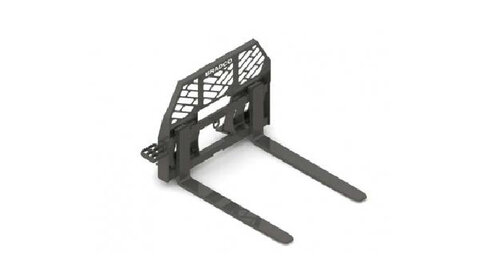Skid steers have become indispensable machines in the construction industry, known for their versatility, compact size and adaptability to a wide range of tasks. Whether youÔÇÖre grading, lifting or hauling, these machines are the backbone of many job sites. But when it comes to tackling the most demanding tasks, a standard skid steer might not cut it. ThatÔÇÖs where high-flow skid steers come into play.
In this article, weÔÇÖll break down what high-flow hydraulics are, how they differ from standard-flow systems and why theyÔÇÖre critical for certain construction jobs.┬á
What Is ÔÇťHigh-FlowÔÇŁ on a Skid Steer?
When you hear the term "high-flow" in the context of skid steers, itÔÇÖs referring to the hydraulic flow rate of the machine. Hydraulic systems power the attachments used by skid steers, and the flow rateÔÇömeasured in gallons per minute (GPM)ÔÇödictates how much power is delivered to the attachment. High-flow systems typically range between 25-45 GPM, compared to the 18-25 GPM youÔÇÖll find in standard-flow models.
A high-flow skid steer delivers more hydraulic fluid to the attachments, allowing them to operate more efficiently and powerfully. If your work involves tasks that require significant hydraulic force, such as forestry or road maintenance, high-flow can be a game-changer.
Why Does High-Flow Matter?
The biggest advantage of a high-flow machine is its ability to handle more demanding tasks, leading to improved productivity. Standard-flow hydraulics are fine for light-to-moderate jobs like material handling or light trenching. But if youÔÇÖre mulching, cold planing or using a snow blower, a standard-flow system may struggle. High-flow skid steers, on the other hand, are built to power these heavier attachments.
Additionally, high-flow systems improve the overall effectiveness of your machine. Attachments work faster and can handle tougher material, meaning jobs get done quicker, which translates to cost savings over time.
Alternatives to High-Flow: Standard-Flow or Low-Flow Systems
While high-flow skid steers are impressive, theyÔÇÖre not necessary for every job. Standard-flow skid steers operate with hydraulic flow rates around 18-25 GPM, which is sufficient for many general tasks. You can use standard-flow systems for digging, loading and grading. TheyÔÇÖre ideal for contractors who donÔÇÖt need heavy-duty attachments.
When deciding between standard and high-flow, the nature of your work should guide your choice. If your tasks demand high power and hydraulic flowÔÇösuch as grinding stumps or clearing dense brushÔÇöa high-flow machine is the clear winner. Otherwise, a standard-flow skid steer may be all you need, saving you on upfront costs.
Capabilities of High-Flow Skid Steers
One of the biggest draws of a high-flow skid steer is the wide range of heavy-duty attachments it can handle. Here are some attachments that require high-flow and why they perform better with it:
- Mulchers: When clearing land, especially in forestry work, a mulcher attachment needs high hydraulic power to chop through thick brush and trees. A standard-flow system would struggle to keep up, leading to slower operation.
- Cold Planers: Used for road work and surface milling, cold planers need precise and consistent hydraulic flow to grind pavement efficiently. High-flow systems ensure that these attachments can remove asphalt quickly, making them essential for resurfacing roads.
- Snow Blowers: In areas with heavy snowfall, clearing roads and job sites quickly is crucial. High-flow systems allow snow blower attachments to move large volumes of snow in less time, making them indispensable for winter work.
- Stump Grinders: Removing tree stumps is another job that benefits from high-flow hydraulics. The increased power allows stump grinders to break through tough wood faster, making land clearing more efficient.
- Brush Cutters: For thick vegetation, a high-flow system provides the power needed for brush cutters to operate at full capacity. This is especially useful in forestry or land-clearing operations.
Activating High-Flow on a Skid Steer
Not all skid steers come equipped with high-flow capabilities out of the box. High-flow is usually an optional feature on many models, requiring a specialized configuration. If you already own a standard-flow skid steer but need high-flow functionality, some manufacturers offer upgrade kits. However, these can be expensive and may not offer the same performance as a machine designed for high-flow from the start. You should also consider your warranty coverage if youÔÇÖre considering upgrading a machine thatÔÇÖs still covered by the manufacturerÔÇÖs warranty, and reach out directly to manufacturers with questions.
To activate high-flow on a skid steer that has it built-in, the process is usually straightforward. Most machines have a control panel or toggle switch that allows you to switch from standard to high-flow. Always refer to your for specifics, as each manufacturer may have different steps.
How High-Flow Impacts Overall Machine Performance
High-flow skid steers arenÔÇÖt just about powering heavier attachmentsÔÇöthey can also impact the overall performance of your machine in several key areas:
- Power and Efficiency: High-flow systems enable attachments to work more efficiently, reducing the time spent on tough tasks. This, in turn, can free up your skid steer for other jobs, boosting overall productivity on your site.
- Horsepower and Lifting Capacity: Some high-flow machines come with increased horsepower, which can provide extra power for pushing when needed. High-flow delivers more power to attachments to increase overall lifting capacity and can handle heavier attachments.
- Fuel Consumption: While high-flow systems are more powerful, they can also increase fuel consumption. Because the hydraulic system is working harder, your machine may burn through fuel more quickly, especially during tasks requiring higher hydraulic power output.
- Longevity and Wear: Running a high-flow system can put additional strain on components like pumps, motors and . ItÔÇÖs essential to stay on top of regular maintenance to avoid costly breakdowns. Components may wear out faster than on standard-flow machines, so be prepared for more frequent if you run high-flow frequently.
Maintaining and Troubleshooting High-Flow Systems
is crucial for keeping your high-flow skid steer in top shape. Common issues with high-flow systems include , and overheating. Ensuring your hydraulic fluid levels are checked regularly and keeping filters clean are essential steps to prevent damage.
Some high-flow-specific issues include wear and tear on attachments that operate under higher pressure. Always inspect your attachments after use to ensure theyÔÇÖre in good working condition. If you notice any drop in performance, such as reduced power or slower operation, it could be a sign of a hydraulic issue that needs to be addressed.
Final Thoughts on High-Flow Skid Steers
High-flow skid steers are a powerhouse on any construction site, offering enhanced capabilities that go beyond what standard-flow machines can achieve. They provide the hydraulic muscle needed for demanding attachments like mulchers, cold planers and stump grinders, boosting efficiency and reducing project times. However, they do come with increased maintenance needs and operational costs, so itÔÇÖs essential to weigh the benefits against the extra investment.
Whether youÔÇÖre managing a job site that requires heavy-duty tasks or looking to increase productivity, high-flow skid steers can be the right tool for the job. By understanding what high-flow brings to the table, you can make an informed decision on whether itÔÇÖs the right fit for your operation.
If youÔÇÖre in need of replacement components for your high-flow skid steer, look no further than the │ď╣¤║┌┴¤═° Shop. Our extensive selection of has you covered. DonÔÇÖt see exactly what your machine needs? Reach out to our dedicated and get personalized assistance.

.svg)
.svg)











